Rice with mushrooms, cuttlefish and artichokes: Daring Cooks August
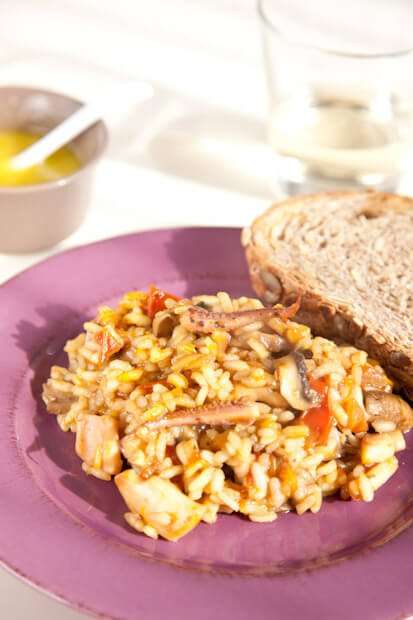
This month Daring Cooks challenge was hosted by Olga from Las Cosas de Olga and Olga’s Recipes she chose a delicious Spanish recipe, Rice with mushrooms, cuttlefish and artichokes by José Andrés, one of the most important Spanish Chefs at the moment.
Ok, can I just start by saying “eeewwwhhh”? Nothing to do with the recipe Olga, don’t get me wrong, but I just cleaned the squid and well, let’s just say that things could have gone a little better! We bought a fresh squid at the market in Amsterdam yesterday and it had everything still in tact; head, insides, everything. I am not sure if that is normal; I just assumed it would be. Didn’t even think to ask the fishmonger if he could clean it for me. Just assumed I was supposed to do it myself.
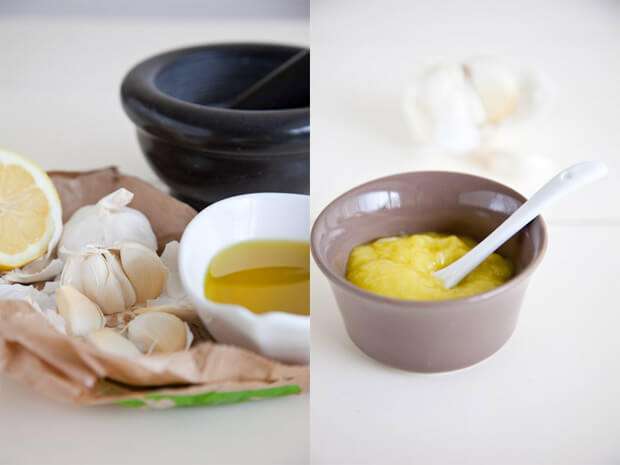
It all started quite well with making the aioli. I chose to make the original classic recipe with just the garlic and the oil and it came out beautifully. Maybe I added a touch to much salt since I halved the recipe and used only two garlic cloves instead of four. But ok, that went fine. Next was the sofregit, which all worked fine too. Slowly sauteed it on a low heat until it all became tender and looked like a proper sauce.
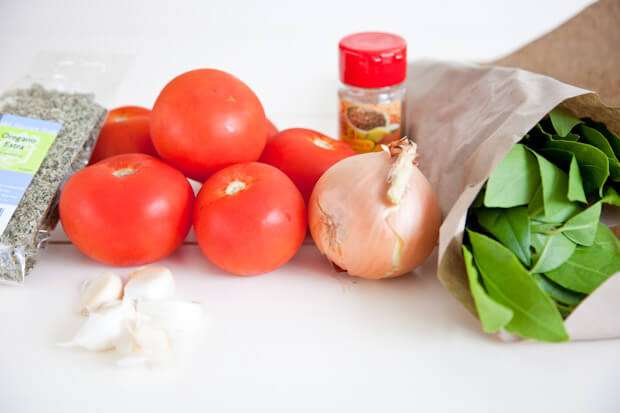
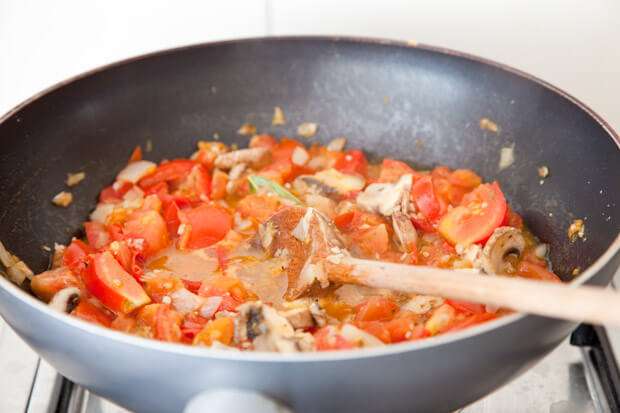
Next I figured I would clean the squid. We couldn’t find a cuttlefish and frankly, finding a squid was already special since they are really hard to find around here. I am not a big fan of squid and wouldn’t normally eat it. First of all, the ones you can find in the restaurants here are all quite rubbery and unappetizing, so making this dish was well, a real challenge in that respect.
I had watched several videos on cleaning squid last night and in fact I had been dreaming about cleaning squid all night! Believe it or not! So when I woke up I figured I had already cleaned about a dozen of those funny creatures so how difficult could it be to do another one?
It started well, I cut of the head of the creature right above the eyes and removed it’s beak as I had seen on Youtube. That worked ok, although still a little bit unnerving to remove a birdlike beak from a seacreature, but ok.
Next the instructions said to pul the head and in that way remove all the insides in one sweep. Not so much! Well the head came of alright, but it broke of releasing all the disgusting insides of my squid. It literally looked like human shit in a rather fluid form…. At that point I was jumping up and down making disgusted noises and going ‘O no, o no…!!!’ ‘Cause you can probably guess what I needed to do next to still remove that crap from the tube…. Yep… put my hand in and pull…. Ofcourse that also didn’t go so well and it all came out in bits and pieces and so not how I had imagined it would go. Brrrr….
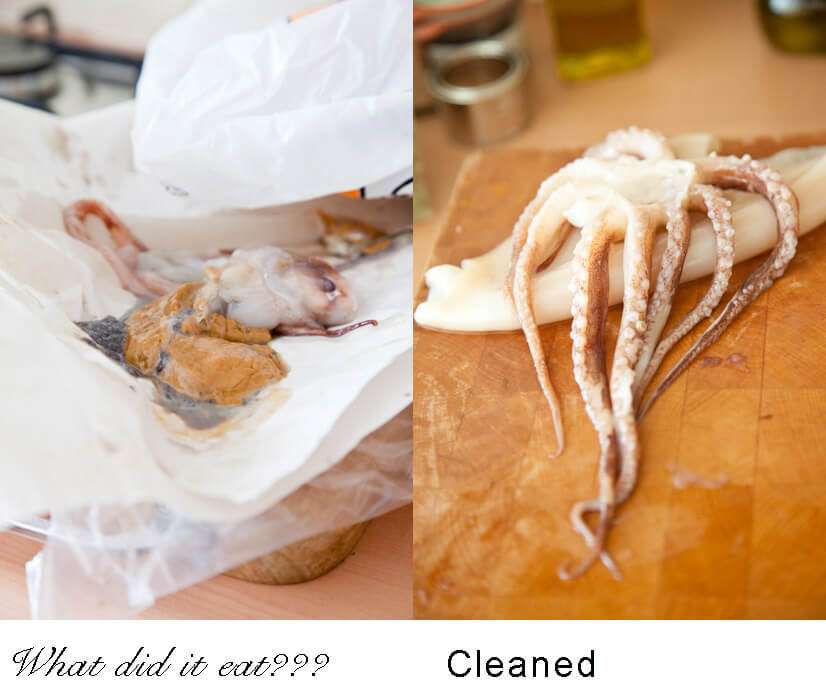
Ok, rinsed the bloody animal clean and next thing I needed to remove was the bit of cartilage in the back which – again according to the instructions – should come out all nice and in one piece… Ofcourse the thing broke of almost immediately, so I ended up cutting away the entire back just to make sure I wouldn’t be ending up with little bits of the cartilage in my mouth later in the evening. Although quite frankly, the furthest thing from my mind, was food at that point!
Removing the little hard rings on the arms did work quite well… Pheww… but then the skin needed removing as well. I tried to pul but my hands were all slippery and I had nothing to hold on to really, so I ended up scraping the skin of with a knife. And again, I am actually still not sure I removed the skin entirely or just the outer layer! It looked still a little bit pinkish although not dramatically, but the only thing I have seen sofar are pure white skins…
And ofcourse only after all that I saw another video that made the task much easier by simply splitting the tube before doing any pulling.. Had I know this upfront… I can certainly say it was an enlightening experience. Haha..
Looking back on the whole “ordeal”, it wasn’t really that bad… I was just a little grossed out over the whole experience and wrote the above literally just minutes after it happened… 🙂 Now a day has passed and I can see things a bit more in perspective and am even thinking of trying this again.
Thankfully the dish itself came out wonderful. It was very tasty and while I may not be adding squid to it in the future (it’s simply not my favorite taste) this would work wonderful with just about any other flavour as well. I used risotto rice, which also worked fine. I had risotto already in the kitchen as I do cook quite a lot of risotto’s so it seemed only the logical way to go.
The taste of the squid was quite good. I had feared it would be rubbery, but the meat was very soft and tender and tasted delicious. So sorry, mr. Squid for being so hard on you before… and thank you for not ruining my dish, just because you were mad… 🙂

I didn’t use the artichokes but I had overbought on the mushrooms so used just mushrooms instead. Not so fond of artichoke anyway, so I didn’t miss it.
The aioli was tasty and did go together really well with the dish, but I should have used less salt and probably more oil. Definitely will be trying that again very soon!
And here is the recipe you’ve all been waiting for!
Rice with mushrooms, cuttlefish and artichokes
Cooking time: 45 minutes
Equipment:
- 1 Chopping Board
- 1 knife
- 1 medium saucepan
- 1 Paella pan (30 cm/11” is enough for 4 people. If not available, you may use a simple pan that size)
- 1 Saucepan
Ingredients (serves 4):
- 4 Artichokes (you can use jarred or freezed if fresh are not available)
- 12 Mushrooms (button or Portobello)
- 1 or 2 Bay leaves (optional but highly recommended)
- 1 glass of white wine
- 2 Cuttlefish (you can use freezed cuttlefish or squid if you don’t find it fresh)
- “Sofregit” (see recipe below)
- 300 gr (2 cups) Short grain rice (Spanish types Calasparra or Montsant are preferred, but you can choose any other short grain. This kind of rice absorbs flavor very well) – about 75 gr per person ( ½ cup per person) Please read this for more info on suitable rices.
- Water or Fish Stock (use 1 ½ cup of liquid per ½ cup of rice)
- Saffron threads (if you can’t find it or afford to buy it, you can substitute it for turmeric or yellow coloring powder)
- Allioli (olive oil and garlic sauce, similar to mayonnaise sauce) – optional
Directions:
- Cut the cuttlefish in little strips.
- Add 1 or 2 tablespoon of olive oil in a frying pan and put the cuttlefish in the pan.
- If you use fresh artichokes, clean them as shown in the video in tip #7. Cut artichokes in eights.
- Clean the mushrooms and cut them in fourths.
- Add a bay leaf to the cuttlefish and add also the artichokes and the mushrooms.
- Sauté until we get a golden color in the artichokes.
- Put a touch of white wine so all the solids in the bottom of the get mixed, getting a more flavorful dish.
- Add a couple or three tablespoons of sofregit and mix to make sure everything gets impregnated with the sofregit.
- Add all the liquid and bring it to boil.
- Add all the rice. Let boil for about 5 minutes in heavy heat.
- Add some saffron thread to enrich the dish with its flavor and color. Stir a little bit so the rice and the other ingredients get the entire flavor. If you’re using turmeric or yellow coloring, use only 1/4 teaspoon.
- Turn to low heat and boil for another 8 minutes (or until rice is a little softer than “al dente”)
- Put the pan away from heat and let the rice stand a couple of minutes.
Sofregit (a well cooked and fragrant sauce made of olive oil, tomatoes, garlic and onions, and may at times
different vegetables such as peppers or mushrooms)-
Cooking time: aprox. 1 hour
Ingredients:
- 2 tablespoons of olive oil
- 5 big red ripe tomatoes, chopped
- 2 small onions, chopped
- 1 green pepper, chopped (optional)
- 4 or 5 garlic cloves, chopped
- 1 cup of button or Portobello mushrooms, chopped (optional)
- 1 Bay leaf
- Salt
- Touch of ground cumin
- Touch of dried oregano
Directions:
- Put all the ingredients together in a frying pan and sauté slowly until all vegetables are soft.
- Taste and salt if necessary (maybe it’s not!)
Allioli is the optional part of the recipe. You must choose one of the two recipes given, even though I highly recommend you to try traditional one. Allioli is served together with the rice and it gives a very nice taste
Allioli (Traditional recipe)
Cooking time: 20 min aprox.
Ingredients:
- 4 garlic cloves, peeled
- Pinch of salt
- Fresh lemon juice (some drops)
- Extra-virgin olive oil (Spanish preferred but not essential)
Directions:
- Place the garlic in a mortar along with the salt.
- Using a pestle, smash the garlic cloves to a smooth paste. (The salt stops the garlic from slipping at the bottom of the mortar as you pound it down.)
- Add the lemon juice to the garlic.
- Drop by drop; pour the olive oil into the mortar slowly as you continue to crush the paste with your pestle.
- Keep turning your pestle in a slow, continuous circular motion in the mortar. The drip needs to be slow and steady. Make sure the paste soaks up the olive oil as you go.
- Keep adding the oil, drop by drop, until you have the consistency of a very thick mayonnaise. If your allioli gets too dense, add water to thin it out. This takes time—around 20 minutes of slow motion around the mortar—to create a dense, rich sauce.
José’s tips for traditional recipe: It’s hard to think that, when you start crushing the garlic, it will ever turn into something as dense and smooth as allioli. But don’t give up. It’s worth the extra time and effort to see the oil and garlic come together before your eyes. Just make sure you’re adding the olive oil slowly, drop by drop. Keep moving the pestle around the mortar in a circular motion and keep dreaming of the thick, creamy sauce at the end of it all.
Allioli a la moderna (Modern recipe)
Cooking time: 3-4 minutes
Ingredients:
- 1 small egg
- 1 cup extra-virgin olive oil (as above, Spanish oil is highly recommended)
- 1 garlic clove, peeled
- 1 Tbs. Spanish Sherry vinegar or lemon juice (if Sherry vinegar is not available, use can use cider or white vinegar)
- Salt to taste
Directions:
- Break the egg into a mixing bowl.
- Add 2 tablespoons of the olive oil and the garlic cloves, along with the vinegar or lemon juice.
- Using a hand blender, start mixing at high speed until the garlic is fully pureed into a loose paste.
- Little by little, add what’s left of the olive oil as you continue blending.
- If the mixture appears too thick as you begin pouring the oil, add 1 teaspoon of water to loosen the sauce.
- Continue adding the oil and blending until you have a rich, creamy allioli.
- The sauce will be a lovely yellow color.
- Add salt to taste.
José’s tips for modern recipe:
(1) If you do not have access to a hand blender, you can use a hand mixer (the kind with the two beaters) or a food processor. If you use a food processor, you must double the recipe or the amount will be too little for the blades to catch and emulsify.
(2) What happens if the oil and egg separate? Don’t throw it out. You can do two things. One is to whisk it and use it as a side sauce for a fish or vegetable. But if you want to rescue the allioli, take 1 tablespoon of lukewarm water in another beaker and start adding to the mix little by little. Blend it again until you create the creamy sauce you wanted.
Olga’s Tips:
(1) In Spain, rice is not stired as often as it is when cooking Italian risotto. You must stir it once or twice maximum. This tip is valid for all Spanish rice dishes like paella, arròs negre, arròs a banda…
(2) When cooking the alternative style you can change the cuttlefish or squid for diced potato.
(3) If you can’t find cuttlefish or squid, or you’re not able to eat them because of allergies, you can try to substitute them for chicken or vegetables at your choice.
(4) Sofregit can be done in advance. You can keep it in the fridge or even freeze it.
(5) For more information on how to clean and remove the heart of artichokes, please watch this video
(6) To watch how Jose Andres cooks this dish click here.
(7) For more information on how to clean and remove the heart of artichokes, please watch this video
(8) To tone down the taste when you do it by hand in a mortar, then add an egg yolk. If you want to tone it down in the alternative way use milk or soy milk. Anyway, the best alternative way is the original oil and garlic alone.
(9) Allioli must be consumed during the preparation day and preserved in the fridge before using it.
(10) For help on conversion on metric to imperial, visit this page.
__________________

Oh Simone! I don’t envy you having to clean that squid! i think next time you should ask them to do it! I like how the final dish turned out though and I bet it was perfect with that creamy aioli!
Lol I was afraid of the squid too so I got the fishmonger to clean it out for me but I still had to peel and do the cartilage myself! Great photos!
Wonderful outcome of the challenge! Beautiful photos and totally in love with the violet plating… Great layout and lighting.. Food turned out delicious!
Regards
Kris
This is a great dish! I loved hearing about the trial and tribulations of cleaning squid; my husband usually does it! But I really love the dish! Yum!
I love the look of your aioli! Wish mine tourned out so good… Great photos – as always 🙂 Cheers!
What a squid cleaning adventure you had!!
I’m glad you liked the dish. Congratulations on your hard work and your pictures, they are beautiful, except for the one of the squid interior… LOL
Ugh – I think I would hsve had to skip out on this one! And yet, you still make it look so beautiful!
Beautiful photographs. I especially like the photo of the squid. Sounds delicious!
Simone..I was in tears of laughter reading about your squid cleaning experience! OMG, funniest ‘play by play’ ever!
Your dish came out gorgeous, regardless of that ‘icky’ squid body LOL I wish I had been there to witness this!
Finally, I AM totally lost without my camera and lens! I wanted to tackle some baked goods this weekend, and now I can’t, plus, it had become like my left arm! I wish you lived closer so I could borrow your other one!!
OOhhhh brave, wrestling an entire squid into submission. =) Yours looks wonderful and what and experience to write home about! Lol. Great Challenge!
LOL! Your description of the squid-cleaning process is hilarious! I used frozen calamari, because I know myself: I could never have cleaned a squid, octopus, or cuttlefish myself. I actually love squid, etc. in a dish, but I’m rather afraid of them when they are alive.
Your rice looks delicious, and I’m especially impressed with how creamy your allioli is. Bravo!
But where is your post Valerie? Should I see it already? It’s not showing up… 🙁
I think that your squid-cleaning experience is exactly what I had envisioned (maybe even worse!) and why I went with the zeevruchten *L* Your allioli looks so good. I am going to try making it again and see if I can get it to the creamy consistency most people have.
Wow! Your dish looks amazing =D. I absolutely love your photos – they’re gorgeous!! Wonderful job with this challenge!
So funny! Thanks for the great anti-tips on cleaning squid. Beautiful photos…love the blog.
What a delightful meal!! So delicious looking!!! Wrestling with a squid!! Well done!!
I love making my own aïoli!
Wow super impressed that you cleaned the squid – what a task! Everything looks great!
Your aioli looks great. The cleaning of the squid: grossness!!!!
Your photos are popping off the screen, they’re beautiful! I’m very impressed that you braved the squid. Nice work!
Wow, great job cleaning the squid! I’ve never attempted that and hope I won’t ever have to, but I do like eating squid. The finished dish looks delicious!
I had a similar reaction to cleaning a skate for last month’s challenge. Usually I am very good at stuff like that but that skate kind of creeped me out. So I can empathize.
Great post.
Oh my – that’s such a gross picture of the squid. You know, after I saw your pictures of the squid in the Daring Cook’s forum, I decided right then that I was going to buy pre-cleaned squid! Thanks so much for sharing that information with all of us! I love your bright pictures!
Well done on cleaning the insides of the squid out. That is one gross picture. You have such lovely pixs and the final dish looks delicious. Cheers from Audax
Beautiful photos as ever. Sounds like you had fun with that squid! Makes me glad I used chicken! Your final dish looks delicous though
Great job. This was my first ever DC challenge. Love your pics.
Your description of the squid-cleaning experience is hiliarous! Your dish looks delicious – love your photos!
Great job on really diving into this challenge! Your photos look beautiful and your description of cleaning the squid is hilarious. =)
I’m so impressed with how beautifully you styled your photos… Something like risotto or paella is so impossible to make beautiful, in my experience!
Oh my… Simone! That was hysterical! I’m sorry you had such an, um, ugly time cleaning the squid! That sounds like a mess 🙂 Great job on the challenge & beautiful pics as always!
First rule, always have your fish and seafood cleaned at the fish market before taking it home :-p When I was a kid I would sometimes go with my dad at 4am to the fish market to buy the freshest seafood for the restaurant during Lent. The worst part of those trips was to stand in a cold smelly warehouse watching their fish getting their guts out. I guess that made appreciate fish even more 😀
I love this recipe. It is so Spanish that it makes me want to dance some flamenco :-p
Well that certainly is a lesson I learned Ben! 🙂 I was just being a bit too convinced I could do this myself! I still think I can though… Just have to practice a bit more! lol
I love the shot of the aioli. I can’t say this makes me want to run out and cook a squid, though!
Ooo what a great recipes, specially the aioli, love it, love it.
The squid? No thank you.
Don’t want to clean is, don’t want to eat is 🙂